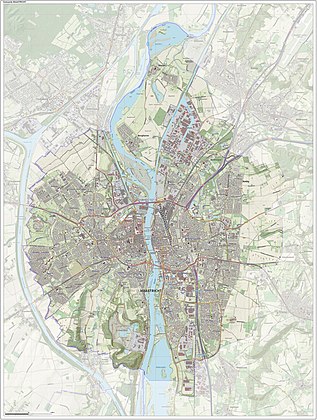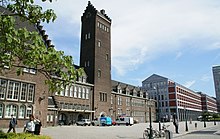Maastricht
![]()
This article describes the Dutch city; for the geological period, see Maastrichtian; for the Treaty of Maastricht, see there.
Maastricht ( ![]() ), until the 20th century also Maestricht [maːˈstrɪxt] (in most Limburg dialects Mesjtreech, but in the Maastricht dialect Mestreech [məˈstʁeːç]), is the capital of the Dutch province of Limburg and one of the oldest cities in the Netherlands.
), until the 20th century also Maestricht [maːˈstrɪxt] (in most Limburg dialects Mesjtreech, but in the Maastricht dialect Mestreech [məˈstʁeːç]), is the capital of the Dutch province of Limburg and one of the oldest cities in the Netherlands.
The name of the town is derived from the Latin Traiectum ad Mosam and Mosae Traiectum ("Meuse crossing"), which probably goes back to the bridge built by the Romans.
The city's coat of arms shows a silver, five-pointed star on a red background, crowned with a golden crown and held by an angelic figure in a blue robe.
Maastricht is a major tourist destination in the Netherlands and a favourite place for education, culture, recreation and shopping. After Amsterdam, the city has the most national monuments (rijksmonumenten). The entire city centre, including the suburb of Wyck, is a listed monument (beschermd stadsgezicht). The university city has a high proportion of international students.
Geography
Geographical location
Maastricht is located in the extreme southeast of the Netherlands, between Belgium and Germany, on both sides of the river Maas. The city centre is at an altitude of about 50 metres above Amsterdam level. The highest point (107 metres AP) is on the Sint Pietersberg in the southwest of the city, although the nearby man-made peak D'n Observant reaches 171 metres in height. The small river Jeker has also formed a valley in the southwest of the city between the Sint Pietersberg and the Cannerberg/Louwberg where some vineyards are located. On the Jeker are several water mills, also in the city centre, where the river divides several times and is only partially visible.
Maastricht borders both Flanders, which has the same language, and Wallonia, which has the same language. Maastricht's peripheral location within the Netherlands is noticeable in many places. Especially in the city centre, with its French-style shops, a strong French-speaking influence is noticeable. The Maastricht Platt spoken by many, like the other Limburg dialects, has much in common with German. It is not only since the Maastricht Treaty of the same name that people in Maastricht consider themselves to be on the "European balcony".
Neighboring communities
The city borders the Belgian municipalities of Lanaken and Riemst (province of Belgian Limburg) to the west, Visé (province of Liège) to the south and the Dutch municipalities of Meerssen, Valkenburg aan de Geul and Eijsden-Margraten to the east.
City breakdown
The city of Maastricht officially consists of seven districts (wijken), which are divided into 44 neighbourhoods (buurten):
- Centrum district: Binnenstad, Jekerkwartier, Kommelkwartier, Statenkwartier, Boschstraatkwartier, Sint-Maartenspoort, Wyck
- Southwest district: Villapark, Jekerdal, Biesland, Campagne, Wolder, Sint Pieter
- Western district: Brusselsepoort, Mariaberg, Belfort, Pottenberg, Malpertuis, Caberg, Oud-Caberg, Malberg, Dousberg-Hazendans, Daalhof
- Northwest district: Boschpoort, Bosscherveld, Frontenkwartier, Belvédère, Lanakerveld
- Eastern district: Wyckerpoort, Heugemerveld, Wittevrouwenveld, Nazareth, Limmel, Scharn, Amby
- North-eastern district: Beatrixhaven, Borgharen, Itteren, Meerssenhoven
- Southeast district: Randwyck, Heugem, Heer, De Heeg, Vroendaal
In addition to the city of Maastricht, the municipality also includes the villages of Itteren (with about 915 inhabitants) and Borgharen (about 1,720 inhabitants), which are located to the north of it. The districts of Limmel, Amby, Heer, Heugem, Caberg, Wolder and Sint Pieter were also formerly independent villages. The centres of these villages have been partly preserved. The original inhabitants of Itteren, Borgharen, Amby and Heer speak a different dialect than those of downtown Maastricht.
Climate
Maastricht and the surrounding area belong to the temperate climate zone and have an oceanic climate, which means humid weather, mild winters and relatively balanced temperatures.
| Maastricht | ||||||||||||||||||||||||||||||||||||||||||||||||
| Climate diagram | ||||||||||||||||||||||||||||||||||||||||||||||||
| ||||||||||||||||||||||||||||||||||||||||||||||||
| Monthly average temperatures and precipitation for Maastricht
Source: wetterkontor.de | ||||||||||||||||||||||||||||||||||||||||||||||||||||||||||||||||||||||||||||||||||||||||||||||||||||||||||||||||||||||||||||||||||||||||||||||||||||||||||||||||||||||||||||||||||||||||||||||||||||||||||||||||||||||||||||||||||||||||||||||||||||||||||||

Topographic map of Maastricht, 2017
Traffic
Shipping
The Meuse is an important river for bulk carriers. South of Maastricht it is connected to the Albert Canal via the canal and the locks of Lanaye (Ternaaien). North of the city, the Juliana Canal begins, which runs parallel to the Maas, which is not navigable there. The industrial harbour of Maastricht is the Beatrix harbour, which lies on the Juliana canal. The Maastricht part of the Zuid-Willemsvaart is of little importance for shipping nowadays. Various excursion ships are moored at the Maas quay in the city centre.
The former historic port of Maastricht has been converted into a marina (basin), which can be reached via the Zuid-Willemsvaart or via a lock to the Maas. Other former harbour basins are occupied by residential boats or are no longer in use. Another lock connects these former harbour parts at the Zuid-Willemsvaart canal with the Maas. Part of the former St Pieter lock is used as a marina. There, the former berths for commercial shipping are largely silted up and shallow. Other marinas can be found both in the city area and on the surrounding Plassen.
Rail and bus transport
Maastricht railway station (Maastricht Station) is connected by rail to Eindhoven and Venlo via Sittard and Roermond and to Liège (Liège-Maastricht railway line); via Heerlen also to Aachen (→ Liège-Maastricht-Aachen-Express). In addition, a bus line runs between Maastricht Central Station and Aachen Central Station. East of Maastricht Central Station is the long-distance bus station. Maastricht Randwyck station is located in the southern district of Randwyck; Maastricht Noord station is located in the north.
Light rail traffic
On 18 December 2012, the city council of Maastricht decided that the transnational project "Tramverbinding Vlaanderen-Maastricht" will be implemented. This is a connection of the centres of Hasselt in Belgium and Maastricht. Between the cities, it will perform the same tasks as the Euregiobahn in Aachen, and within the cities it will run right into the city centre. The largest part of the line is on Belgian territory. This part is part of the 300 million Spartacus plan, which is intended to bring a number of improvements to regional transport in Belgian Limburg.
For the city of Maastricht, two stations are planned (in the newly developing Sphinx Quarter and at the current bus stop "Mosae Forum"). On the Belgian side, a total of nine stations are planned. A planning approval procedure has been carried out and all preparations are underway. The execution of the necessary works is expected to take about three years. According to current plans, construction work is to begin in 2020. If everything goes according to plan, the first light rail will roll through Maastricht and Hasselt in 2023.
Road traffic
The A2 motorway running east of the Meuse connects Maastricht with Amsterdam and Liège, the A79 with Heerlen and further via the A76 / A 4 (D) with Aachen. A part of the A2 route east of the old city was not yet a motorway (N2) for a distance of about 1.5 km until the end of 2016. This stretch was upgraded to intersection-free by the King Willem Alexander Tunnel, which should bring about a solution to the daily traffic problems.
Air traffic
About ten kilometres north of the city centre is the international but small Maastricht Aachen Airport. It is also home to Eurocontrol's Maastricht Upper Area Control Centre (Maastricht UAC), from where the upper flight corridors of north-west Germany, the Benelux countries and northern France are monitored.
.jpg)
King Willem Alexander Tunnel

Central station and office building by Hans Kollhoff

Youngest and oldest of the 6 Maas bridges in Maastricht

Navigation on the Juliana Canal
Questions and Answers
Q: What is the name of the city in the south of Netherlands?
A: The city is called Maastricht.
Q: How many people live in Maastricht?
A: Approximately 120,000 people live in Maastricht.
Q: Does Maastricht have an airport and a university?
A: Yes, it does. It has an airport and a university called Maastricht University.
Q: When was the first settlement founded in that region?
A: The first settlement was founded in the Stone age about 25000 years ago.
Q: Who founded the first permanent settlement there?
A: The Celts founded the first permanent settlement about 500 B.C.
A::When did Maastricht get City Rights?
A: Maastricht got City Rights in 1204.
Q::Since when does Maastricht belong to Netherlands?
A::Maastricht has belonged to Netherlands since 1815 after Napoleonic Wars.
Q::What treaty was signed in Maastricht?
A::The European Contract of 1992, also known as Treaty of Maastricht, was signed in Maastricht
Search within the encyclopedia